|
|

|
|
HOME
|
|
ABOUT WAC
|
|
The STORY
|
|
EVENTS / NEWS
|
|
RESOURCES
|
|
CONTACT US
|
|
LINKS to Related Info
|
|
|
COMING EVENTS
CHECK HERE
...for even more events, coming soon!
Whoever you are, COME SEE WICHITA AVIATION.
For links to
Wichita aircraft & aviation topics
mentioned or depicted on the covers of
recent issues
of
leading aviation magazines
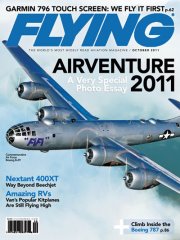
CLICK HERE...
.
W.A.C. IMAGES
FOR JOURNALISTIC
& EDUCATIONAL
USE ONLY
CLICK IMAGES
TO ENLARGE
Please credit:
"Wichita Aviation Centennial Cmte."
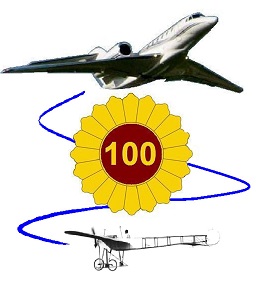
WAC Logo
For Journalistic Use Only, in covering activities of (or sanctioned by) the Wichita Aviation Centennial Committee.
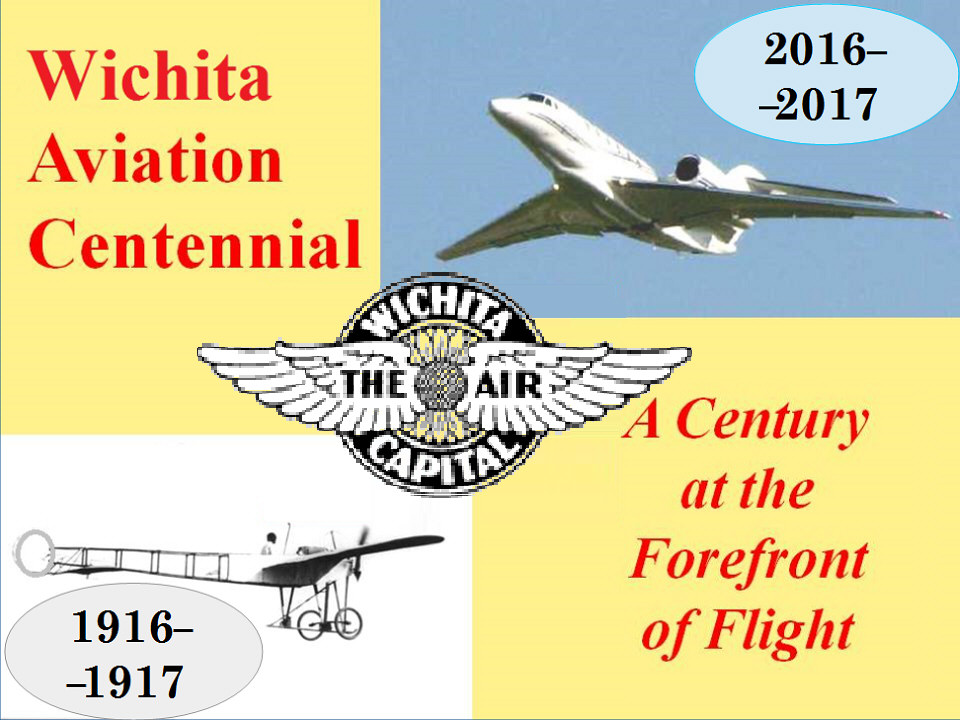
WAC Banner Logo
For journalistic & educational use only
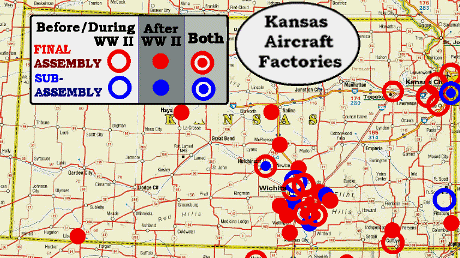
Kansas Aircraft Factories,
past & present
For journalistic & educational use only
|
|
|
|
EVENT PHOTOS:
OCT 1-2:
EAA Air Capital Fly-In
Entertains and Educates,
and Hosts Son of Stearman
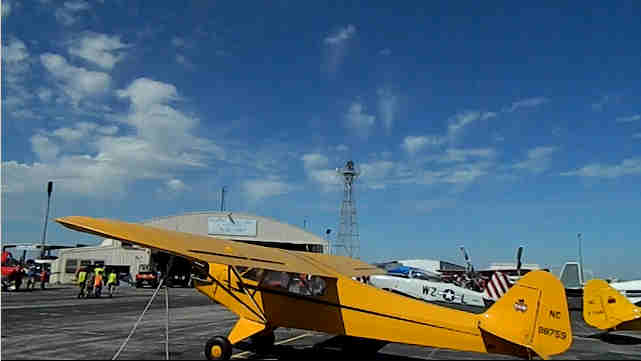 NEWTON, KS, Oct.1
NEWTON, KS, Oct.1
Experimental Aircraft Assn. (EAA) Chapter 88, of Wichita, held its annual Air Capital Fly-In and Banquet at Newton City-County Airport, 25 miles north of the Air Capital City, Saturday Oct. 1, 2016.
For the article,
CLICK HERE
For photos from Sunday's activity at the Stearman hangar at McConnell Air Force Base, and later at the Kansas Aviation Museum,
CLICK HERE
For photos from Saturday's activity at the Newton airport, SEE BELOW:
NOTE: Photos below are compressed, high-resolution images, and may take a couple of minutes to load completely. However, once loaded, you can click on them to instantly pop up a full-size version of the photo. Higher quality images, with captions, are available upon request.
 Piper Cub, the classic antique of light planes. Built by the thousands in the 1930s and early 1940s, these were the planes that initially taught most U.S. pilots from then until the mid-1950s. On a scant 65 horsepower, the plane manages 75mph in calm air, carrying two in tandem. They remain popular today. Behind it, the classic antique beacon and hangar at Newton City-County Airport.
Piper Cub, the classic antique of light planes. Built by the thousands in the 1930s and early 1940s, these were the planes that initially taught most U.S. pilots from then until the mid-1950s. On a scant 65 horsepower, the plane manages 75mph in calm air, carrying two in tandem. They remain popular today. Behind it, the classic antique beacon and hangar at Newton City-County Airport.
|
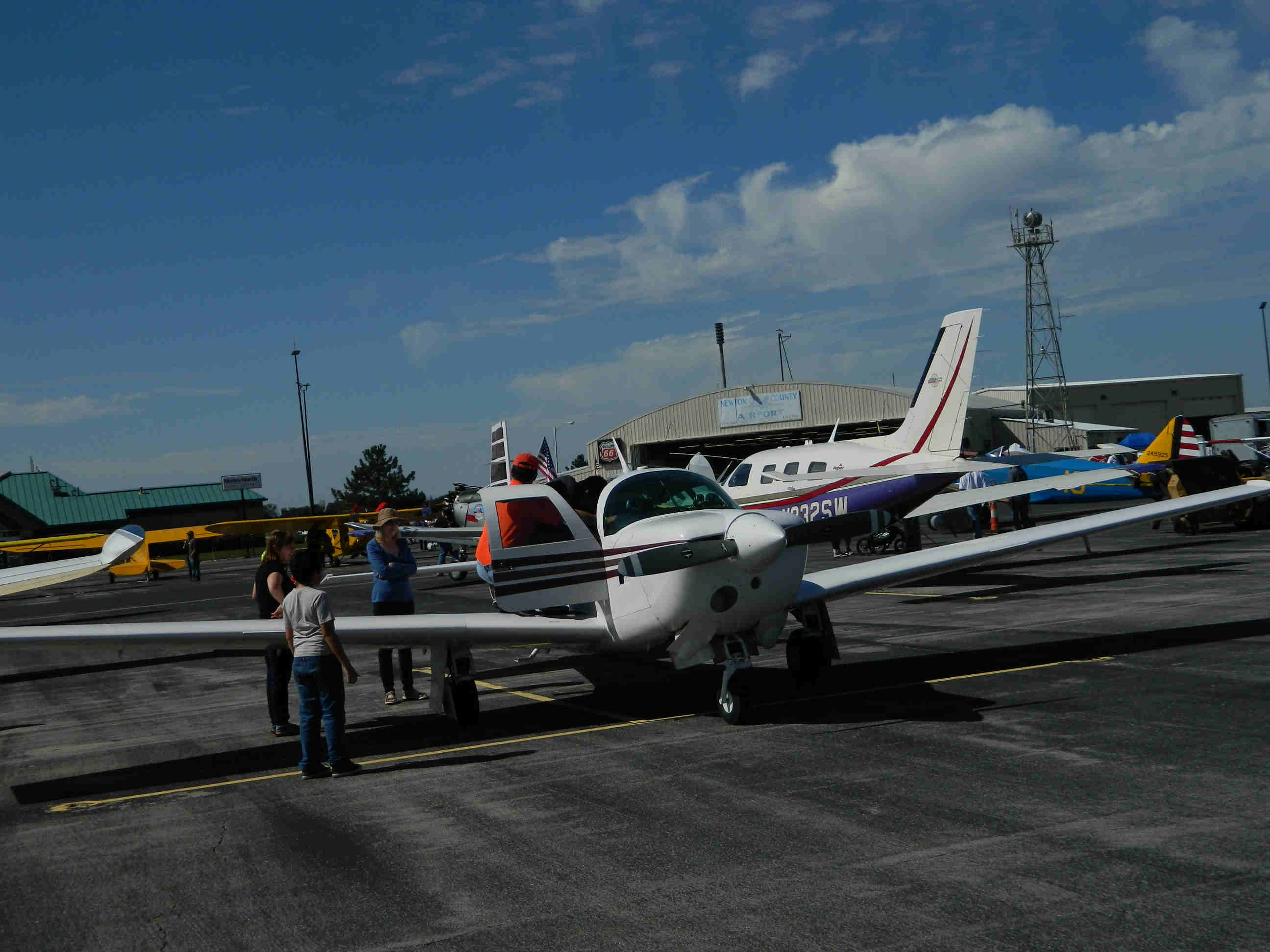 "Young Eagles" board a Mooney for a first flight experience. EAA has long encouraged its members to share the gift of flight with the next geneation, resulting in EAA's "Young Eagles" program offering flight experiences for kids between the agest of 8 and 17. At this fly-in, an estimated 87 kids were given rides.
"Young Eagles" board a Mooney for a first flight experience. EAA has long encouraged its members to share the gift of flight with the next geneation, resulting in EAA's "Young Eagles" program offering flight experiences for kids between the agest of 8 and 17. At this fly-in, an estimated 87 kids were given rides.
|
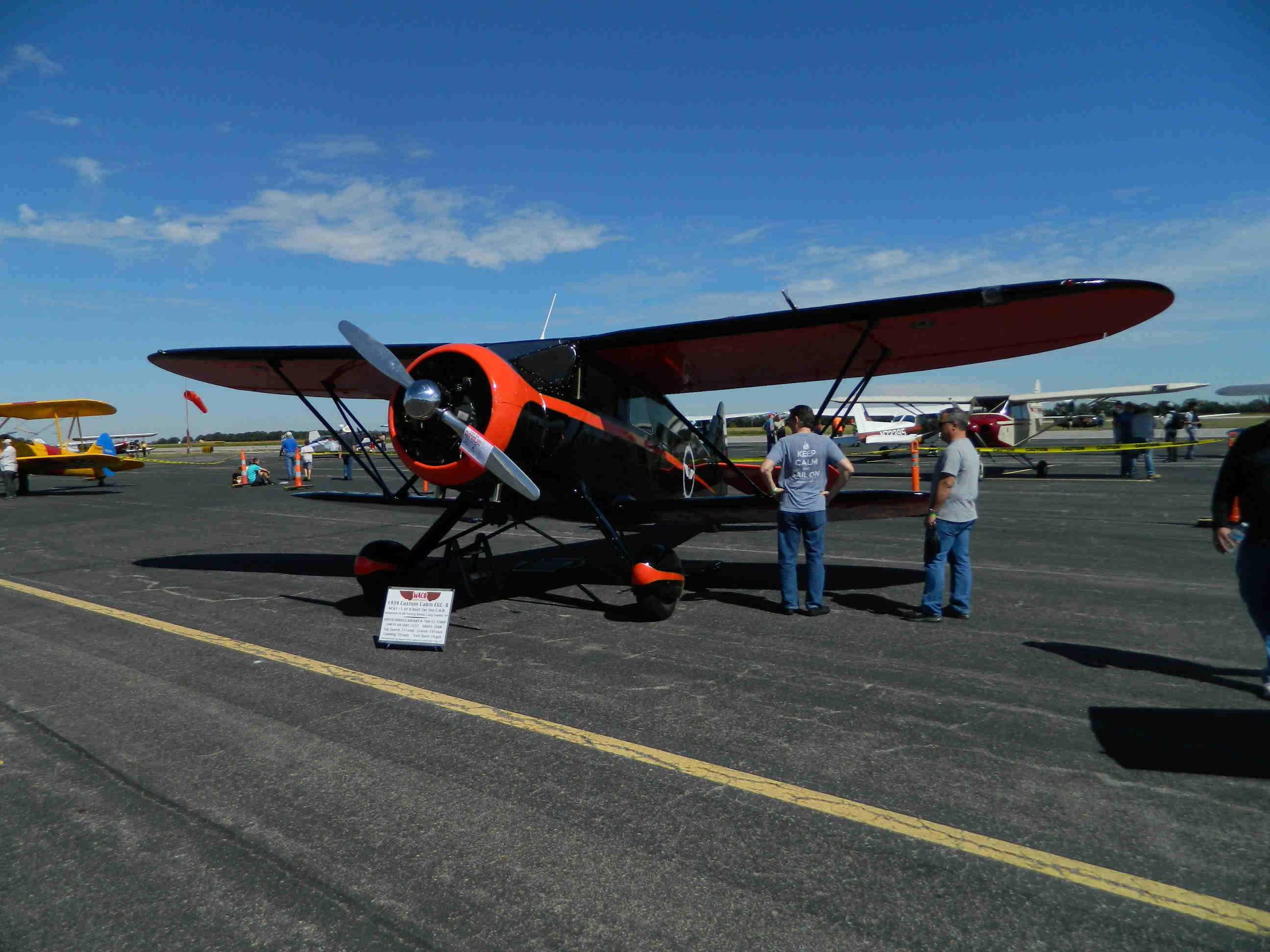 Elegant WACO cabin biplane of the 1930s, built by Wichita's strongest competitor in the civilian light plane market of the 1920s. Ohio-based WACO -- a contraction of "Weaver Aircraft Company," named for former Wichita Laird aircraft worker Buck Weaver, produced the most American civilian airplanes of the 1920s, but got edged out by Wichita's Travel Air -- formed partly by Weaver's former co-workers Walter Beech and Lloyd Stearman -- in 1928.
Elegant WACO cabin biplane of the 1930s, built by Wichita's strongest competitor in the civilian light plane market of the 1920s. Ohio-based WACO -- a contraction of "Weaver Aircraft Company," named for former Wichita Laird aircraft worker Buck Weaver, produced the most American civilian airplanes of the 1920s, but got edged out by Wichita's Travel Air -- formed partly by Weaver's former co-workers Walter Beech and Lloyd Stearman -- in 1928.
|
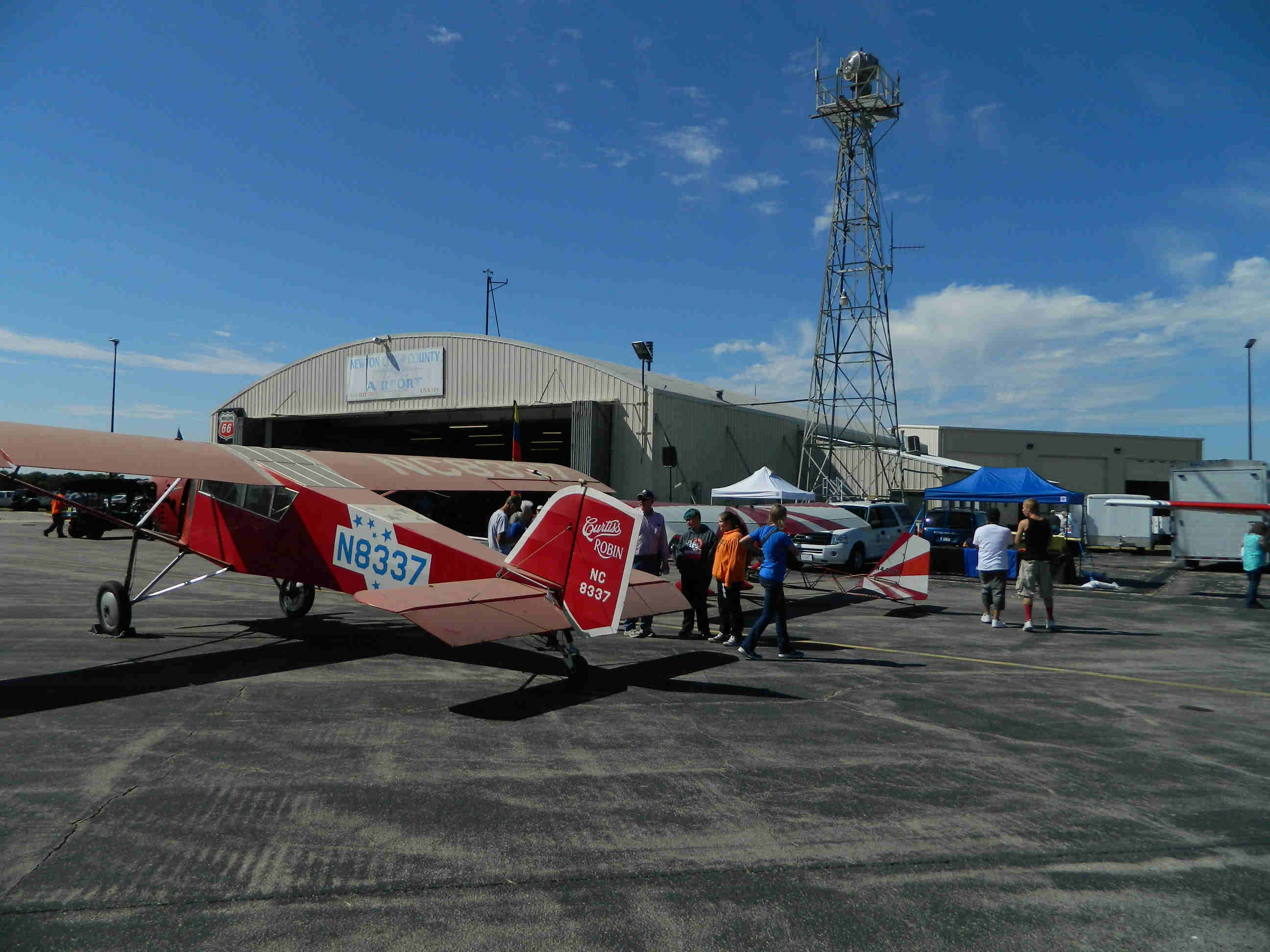 Rare, three-seat 1920s-era Curtiss Robin, one of America's very first enclosed-cabin aircraft, and a major competitor to Wichita's popular planes of the 1920s. This one belongs to EAA member Dave Blanton, and made a rare appearance at the fly-in. Beyond it are a couple of other aviation antiques: The old 1930s-style rotating-beacon tower of Newton Airport, and a round-topped corrugated-tin hangar typical of mid-20th Century aviation.
Rare, three-seat 1920s-era Curtiss Robin, one of America's very first enclosed-cabin aircraft, and a major competitor to Wichita's popular planes of the 1920s. This one belongs to EAA member Dave Blanton, and made a rare appearance at the fly-in. Beyond it are a couple of other aviation antiques: The old 1930s-style rotating-beacon tower of Newton Airport, and a round-topped corrugated-tin hangar typical of mid-20th Century aviation.
|
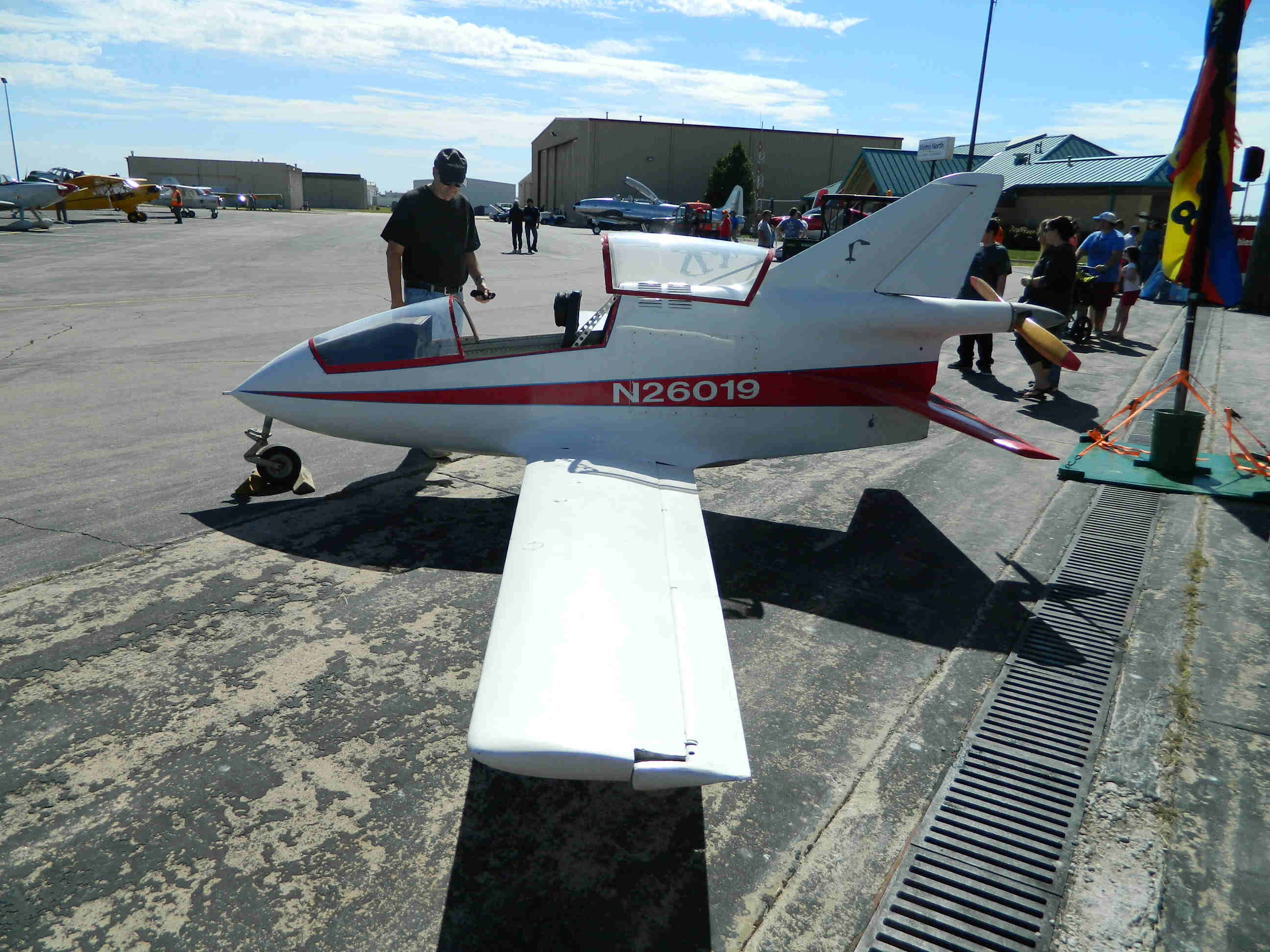 Bede BD-5 Micro, one of the world's smallest planes (a jet-powered model -- the BD-5J MicroJet -- is the world's smallest jet). Designed by Wichita State University aeronautical engineering graudate Jim Bede, with help from budding aerospace pioneer Burt Rutan, the BD-5 was originally sold as a kit, produced at this airport, in Newton, in the early-1970s, by Bede Aircraft. Though technically flawed and a commercial failure, the plane so fired the imagination of would-be plane-builders, everywhere, that it essentially ignited the "kitplane" movement, which today results in thousands of planes built this way. This BD-5 was provided by the Kansas Aviation Museum.
Bede BD-5 Micro, one of the world's smallest planes (a jet-powered model -- the BD-5J MicroJet -- is the world's smallest jet). Designed by Wichita State University aeronautical engineering graudate Jim Bede, with help from budding aerospace pioneer Burt Rutan, the BD-5 was originally sold as a kit, produced at this airport, in Newton, in the early-1970s, by Bede Aircraft. Though technically flawed and a commercial failure, the plane so fired the imagination of would-be plane-builders, everywhere, that it essentially ignited the "kitplane" movement, which today results in thousands of planes built this way. This BD-5 was provided by the Kansas Aviation Museum.
|
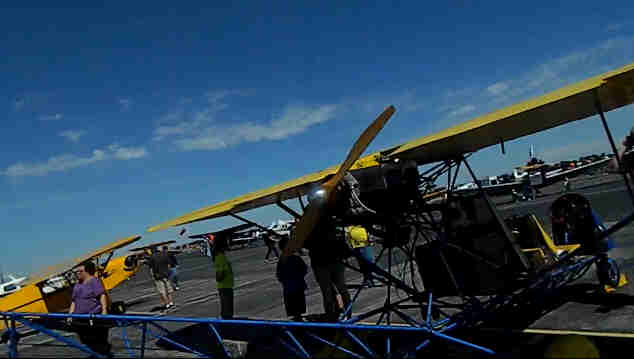 The "out-in-the-breeze" airplane, the "Breezy," a popular experimental design -- pre-dating ultralights -- that uses conventional wings and tail, mated to a pusher-prop engine and a slender metal frame with seats mounted on top, in the open.
The "out-in-the-breeze" airplane, the "Breezy," a popular experimental design -- pre-dating ultralights -- that uses conventional wings and tail, mated to a pusher-prop engine and a slender metal frame with seats mounted on top, in the open.
|
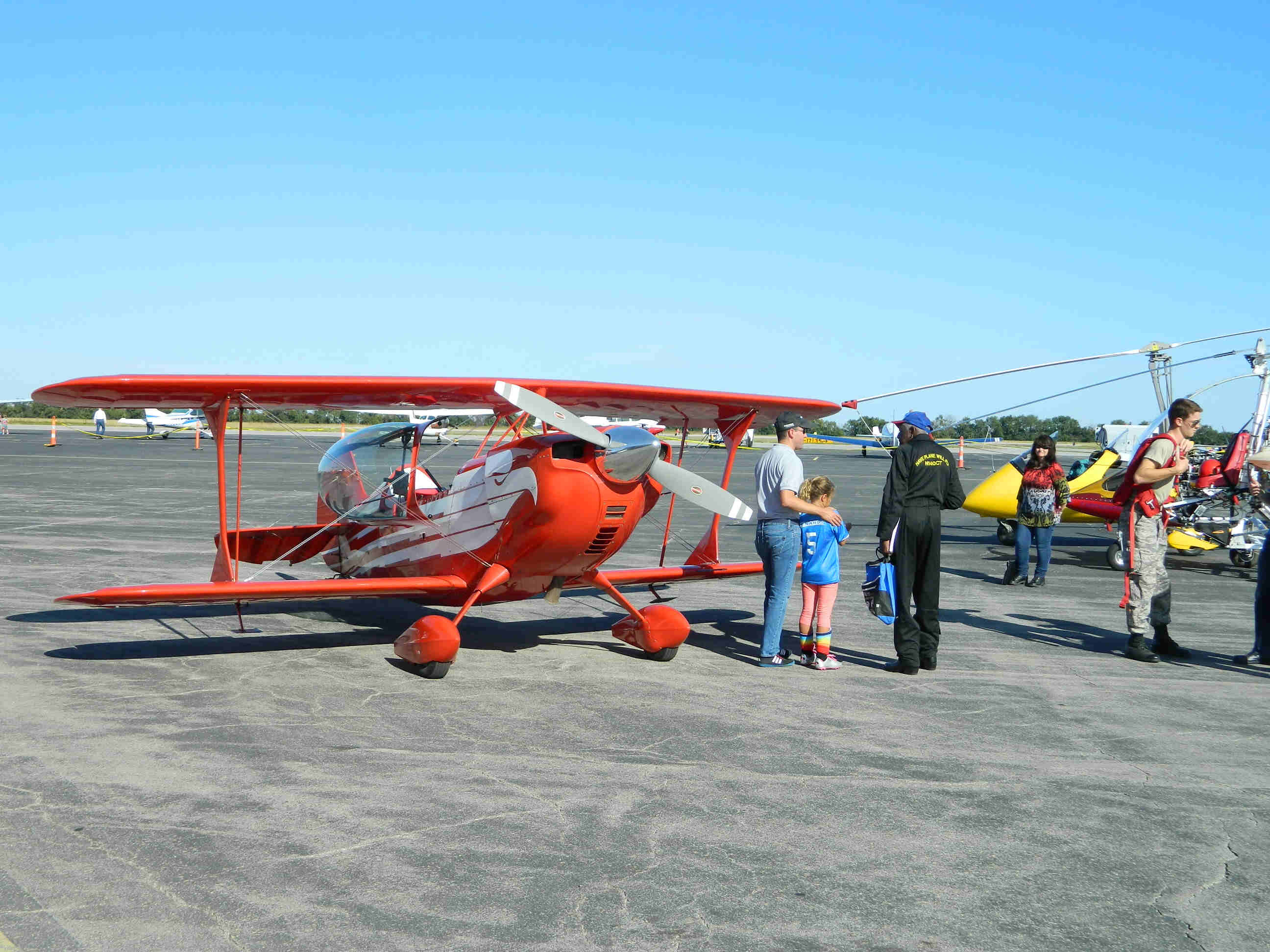 Stunt-plane, whirlybirds and a legend.
A bright-red Christen Eagle aerobatic biplane, a popular kitplane crafted for the rigors of acrobatic flight for the stunt-flying community, with a bubble canopy providing enclosed-cabin comfort for long cross-country trips.
Stunt-plane, whirlybirds and a legend.
A bright-red Christen Eagle aerobatic biplane, a popular kitplane crafted for the rigors of acrobatic flight for the stunt-flying community, with a bubble canopy providing enclosed-cabin comfort for long cross-country trips.
For an even less conventional way to travel, in the right background, are a pair of two-seat gyrocopters -- propelled by pusher props, with a free-wheeling "auto-gyrating" rotor for lift; as the propellor moves the craft forward, the wind spins the rotor, which generates lift. Spot landings are possible, and takeoffs after very short runs.
A tall black man, in black jumpsuit -- local aviation legend "Rip" Gooch, a 20,000-hour pilot and aviation entrepreneur, still flying at over 90, who retired as Kansas's longest-serving state senator -- regales visitors with tales of Wichita aviation.
|
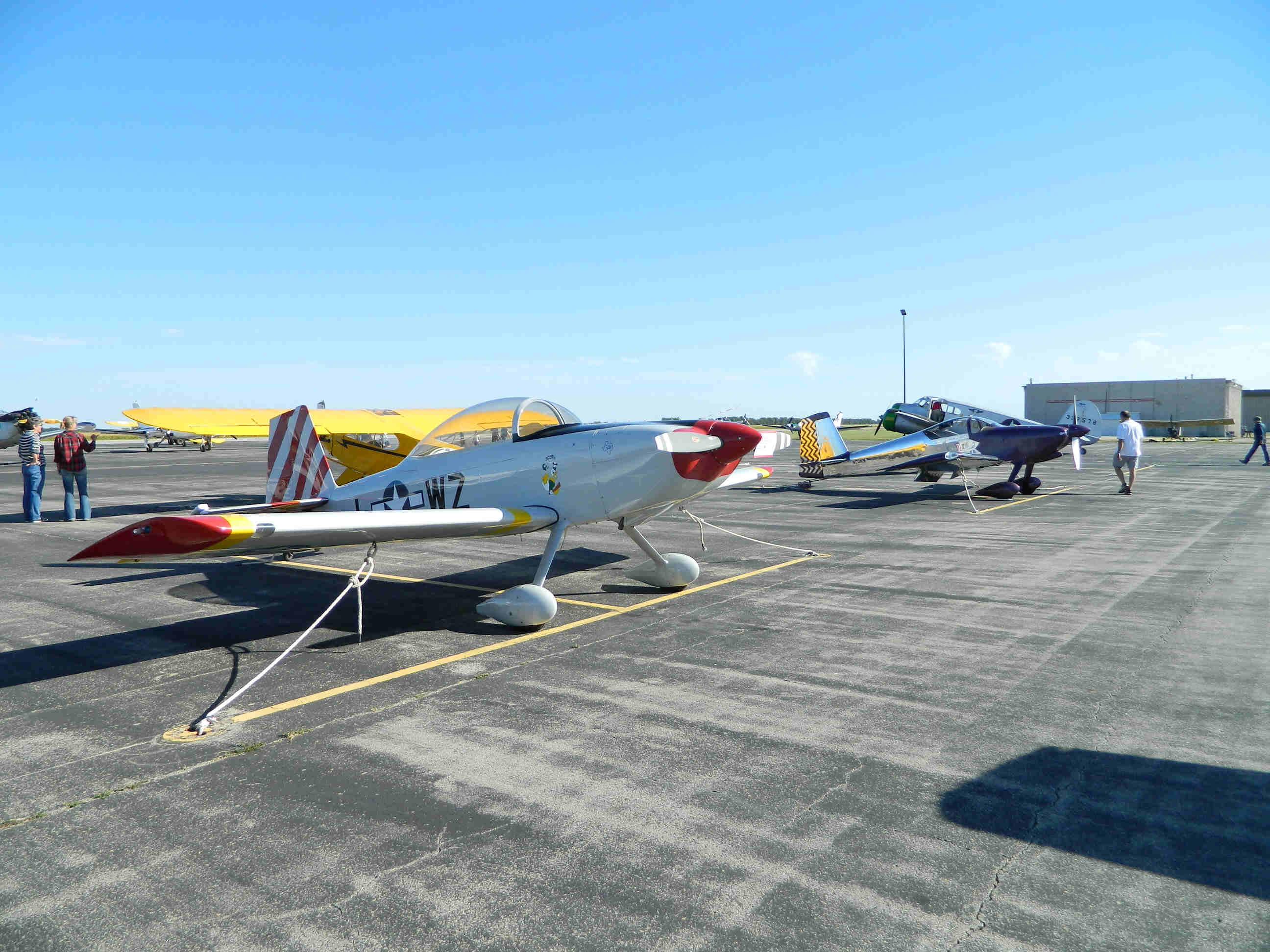 A pair of sleek, modern Vans kitplanes, capable of speeds well over 150 mph, and acrobatics, show the leading trend of today's EAA home-builders.
A pair of sleek, modern Vans kitplanes, capable of speeds well over 150 mph, and acrobatics, show the leading trend of today's EAA home-builders.
Behind them, the past, with a traditional yellow "rag-wing" Piper Cub and a silver-painted, fabric-skinned, twin-engined Cessna T-50 Bobcat, in its World War II markings as the principal multiengine trainer for future bomber and transport pilots. The Bobcat, operated by the Commemorative Air Force (CAF) Jayhawk Wing at Wichita's Westport Airport, sits ready to sell radial-engine rides into the past.
All four planes share a common trait, rare today: tailwheels.
|
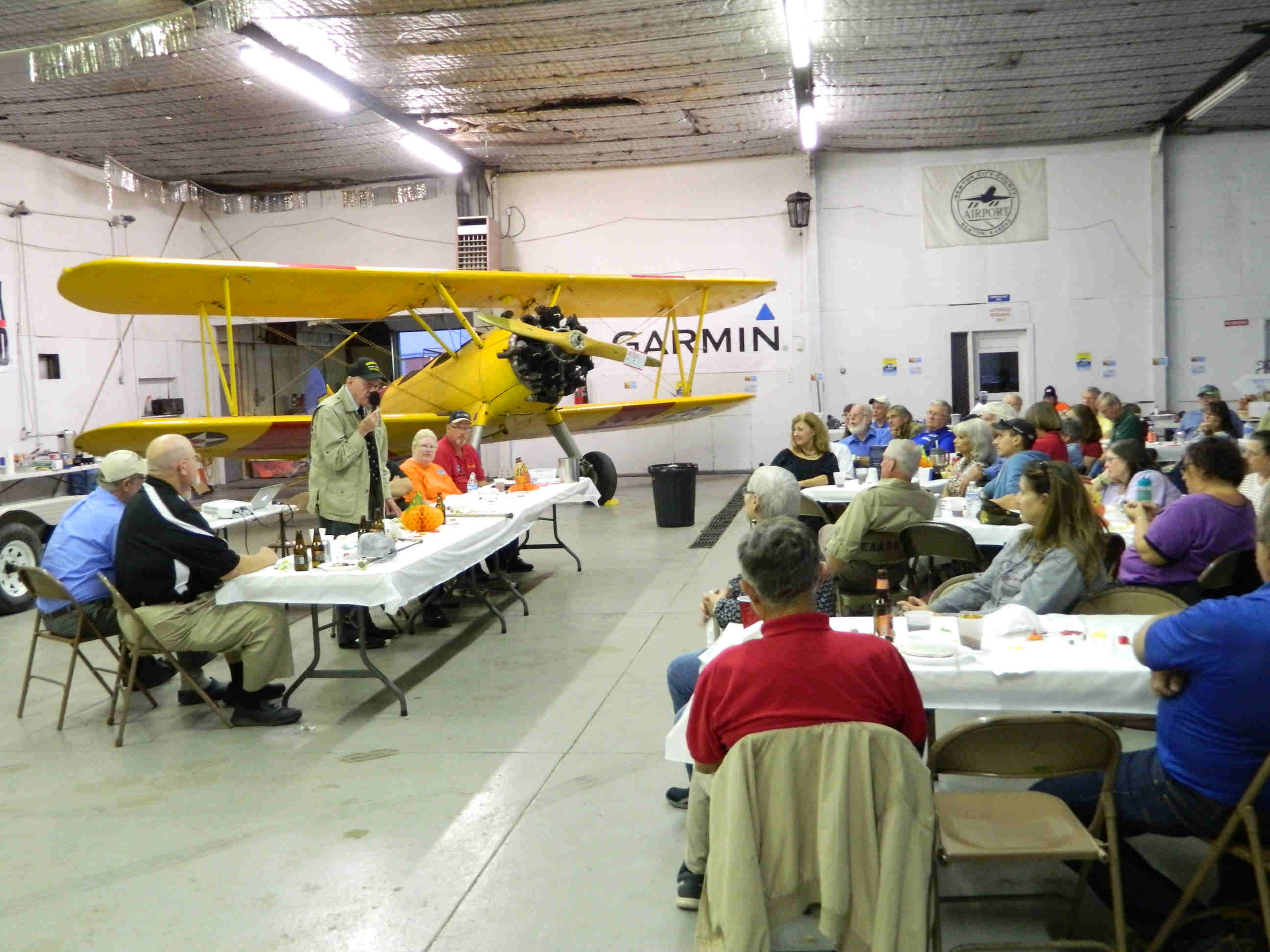 At the Fly-In's awards banquet, in front of his father's last biplane design, Dr. William L. Stearman -- son of aviation legend and Wichita aviation pioneer Lloyd Stearman -- shares intimate memories of his father's years shaping the Wichita aviation industry, and his father's later career in the aviation industry of the West Coast.
At the Fly-In's awards banquet, in front of his father's last biplane design, Dr. William L. Stearman -- son of aviation legend and Wichita aviation pioneer Lloyd Stearman -- shares intimate memories of his father's years shaping the Wichita aviation industry, and his father's later career in the aviation industry of the West Coast.
Dr. Stearman also shared experiences and observations from his own military career and 17 years as a presidential adviser on the National Security Council at the White House.
|
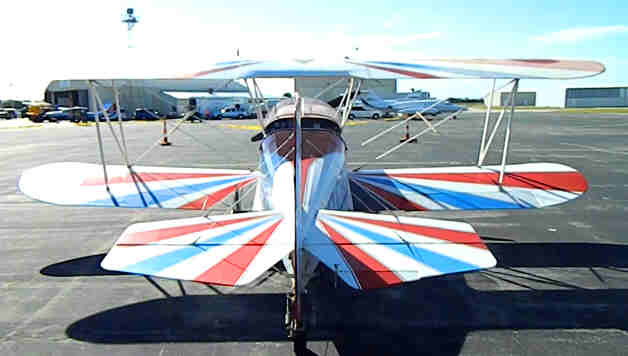 The "Wichhawk" -- a rare homebuilt design of the 1960s -- offered exceptional acrobatic capability (its wings stressed to survive 12 "G"s!), and a rarity for open-cockpit airplanes: sociable side-by-side seating for pilot and passenger. Designed by the late Wichita Dave Blanton, Sr. -- a leading Wichita aviation engineer -- it remains active today in his family's hands.
The "Wichhawk" -- a rare homebuilt design of the 1960s -- offered exceptional acrobatic capability (its wings stressed to survive 12 "G"s!), and a rarity for open-cockpit airplanes: sociable side-by-side seating for pilot and passenger. Designed by the late Wichita Dave Blanton, Sr. -- a leading Wichita aviation engineer -- it remains active today in his family's hands.
|
For photos from Sunday's activity at the Stearman hangar at McConnell Air Force Base, and later at the Kansas Aviation Museum,
CLICK HERE
For the article,
CLICK HERE
To Return to the EVENTS & NEWS pageCLICK HERE
FOR MORE INFORMATION ,
contact the:
Wichita Aviation Centennial Committee
Richard Harris, Chariman,
(316) 371-9079
office@ks100aviation.org

|
|
Join us in celebrating
a Century of Wichita Aviation!
|
|
|
|
HOME
|
ABOUT US
|
The STORY
|
EVENTS
|
RESOURCES
|
CONTACTS
|
LINKS
|
|
|